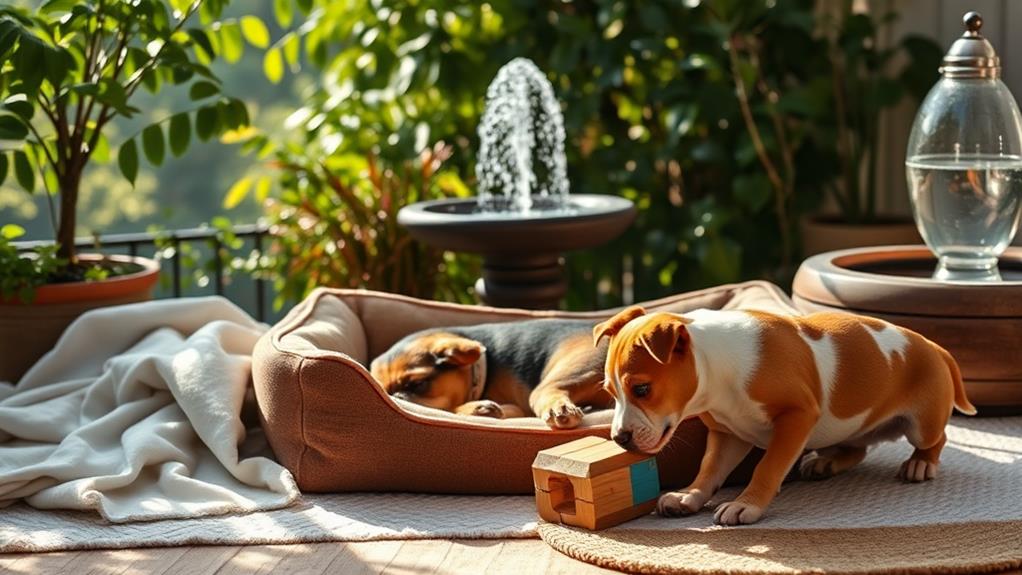To help your anxious dog relax, create a safe space where they feel secure. Fill it with cozy bedding and their favorite toys. Use calming techniques like gentle massages and soothing sounds, such as soft music. Regular exercise is vital, so daily walks and playtime can help release built-up energy. Pay attention to their diet, choosing high-quality food that supports mood. Socialization is also important, as it can build confidence. If your dog's anxiety persists, don't hesitate to seek professional help for tailored solutions. There's plenty more you can explore to safeguard your furry companion feels at ease.
Understanding Canine Anxiety

Understanding canine anxiety starts with recognizing its signs and triggers. You might notice that your dog seems restless, barks excessively, or hides when faced with certain situations. These behaviors often indicate underlying anxiety. It's crucial to pay attention to what specifically causes your dog to feel anxious. Common triggers include loud noises, unfamiliar environments, changes in routine, or even the presence of strangers.
Next, consider your dog's breed and history. Some breeds are more prone to anxiety, while past experiences can also shape their reactions. If your dog has faced trauma, it may be more sensitive to certain stimuli. Identifying these factors can help you create a supportive environment for your furry friend.
Your approach to managing canine anxiety should be proactive. Create a safe space where your dog feels secure, and introduce them gradually to potential triggers. Consistency is key; maintaining routines can instill a sense of stability for your dog. By understanding the nuances of canine anxiety, you're taking the first step toward helping your dog feel more at ease and relaxed in their surroundings.
Signs of Stress in Dogs
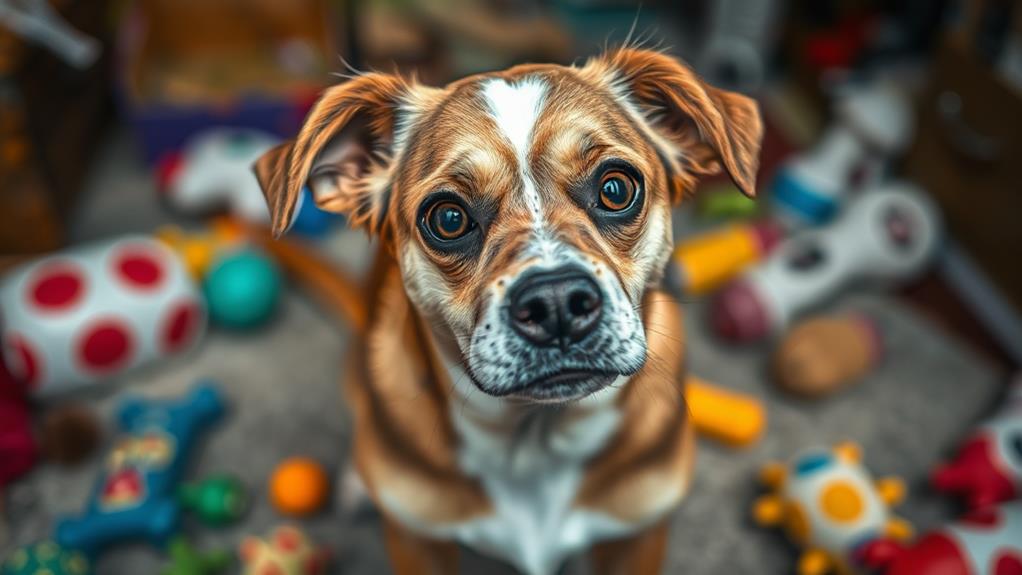
Recognizing signs of stress in dogs is essential for addressing their anxiety effectively. You'll want to keep an eye out for various behaviors that indicate your dog is feeling overwhelmed. Common signs include excessive barking or whining, which often signals distress. If your dog starts to hide, seeks isolation, or avoids eye contact, it's a clear indication they're not comfortable.
Physical changes can also point to stress. Pay attention to a tucked tail, flattened ears, or a lowered body posture. These signs suggest your dog is feeling anxious or submissive. Additionally, you might notice panting, drooling, or pacing, which can be signs of agitation.
Watch for destructive behaviors, like chewing furniture or digging, as these often arise from anxiety. If your dog shows changes in appetite, either eating less or overeating, that's another red flag. Finally, if your dog suddenly becomes more aggressive or fearful in situations they used to handle well, it's important to take note.
Creating a Safe Space
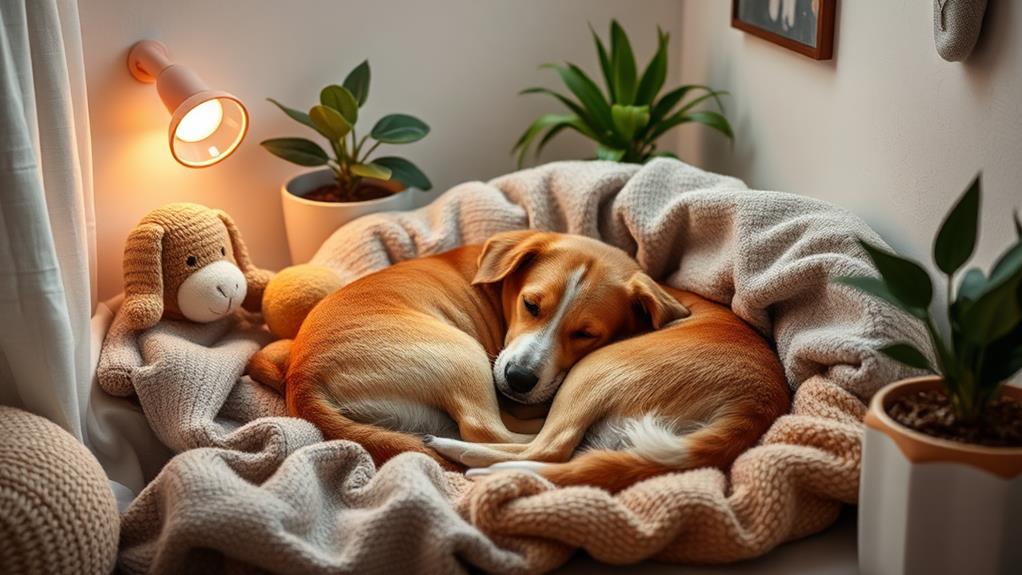
Creating a safe space for your anxious dog is crucial for helping them feel secure and calm. This area should be a quiet, comfortable spot where your dog can retreat whenever they feel overwhelmed. You can make this space inviting and reassuring by incorporating familiar items that bring them comfort and joy.
Cozy bedding: A soft, plush bed will provide comfort and warmth.
Favorite toys: Include their beloved toys to encourage play and distraction.
Scented items: Items with your scent can help soothe them and reinforce a sense of safety.
Low lighting: Dim lighting can create a calming atmosphere, reducing anxiety.
Barrier or enclosure: A crate or small room can help define their space and minimize distractions.
Calming Techniques for Dogs
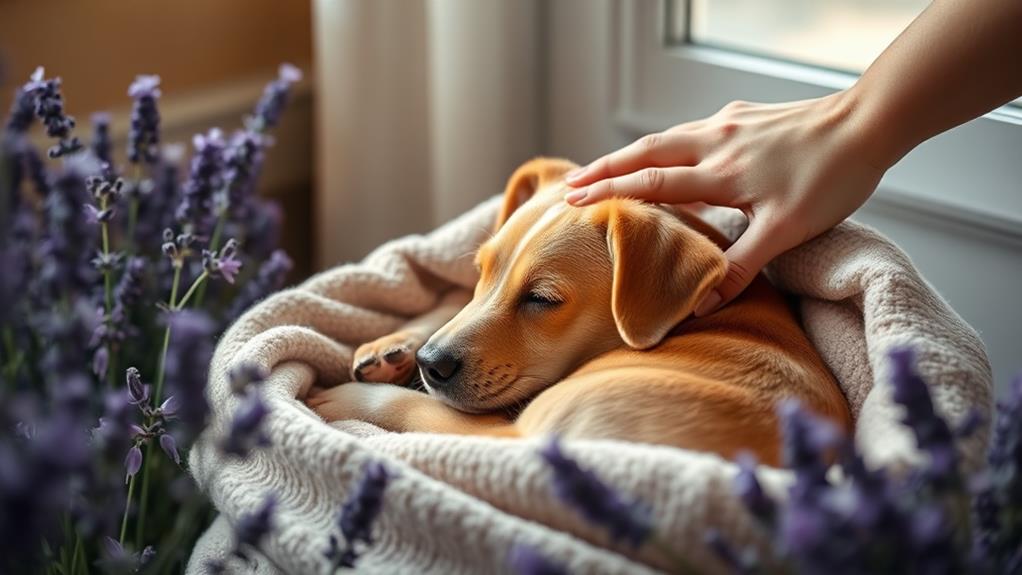
Many dog owners find that implementing calming techniques can substantially ease their pet's anxiety. One effective method is using soothing sounds. Soft music or white noise can mask unsettling noises, creating a more peaceful environment. You might also try playing a recording of calming sounds designed specifically for dogs.
Another technique involves the use of aromatherapy. Essential oils like lavender or chamomile can have a calming effect. Just be sure to verify the use of dog-safe oils and consult your vet before trying this approach.
Massage can also work wonders. Gently massaging your dog's neck, shoulders, and back can help relieve tension and promote relaxation. Pay attention to your dog's body language to guarantee they're comfortable.
Additionally, consider using anxiety wraps or calming vests. These snug garments provide gentle pressure that can help your dog feel more secure during stressful situations.
Lastly, teaching your dog simple commands, like "sit" or "stay," can redirect their focus and provide a sense of structure. By incorporating these calming techniques into your daily routine, you'll create a more relaxed atmosphere for both you and your furry friend.
The Power of Exercise

In addition to calming techniques, incorporating regular exercise into your dog's routine can greatly alleviate anxiety. Exercise is essential for your dog's physical and mental well-being. It helps release pent-up energy, reduces stress hormones, and promotes the production of endorphins, which can enhance your dog's mood.
Consider these effective ways to get your furry friend moving:
- Daily walks: Aim for at least 30 minutes of brisk walking each day.
- Play fetch: This classic game provides both exercise and bonding time.
- Agility training: Set up an obstacle course to stimulate your dog's mind and body.
- Doggy playdates: Socializing with other dogs can reduce anxiety and improve confidence.
- Swimming: If your dog enjoys water, swimming is a low-impact way to exercise.
Utilizing Aromatherapy
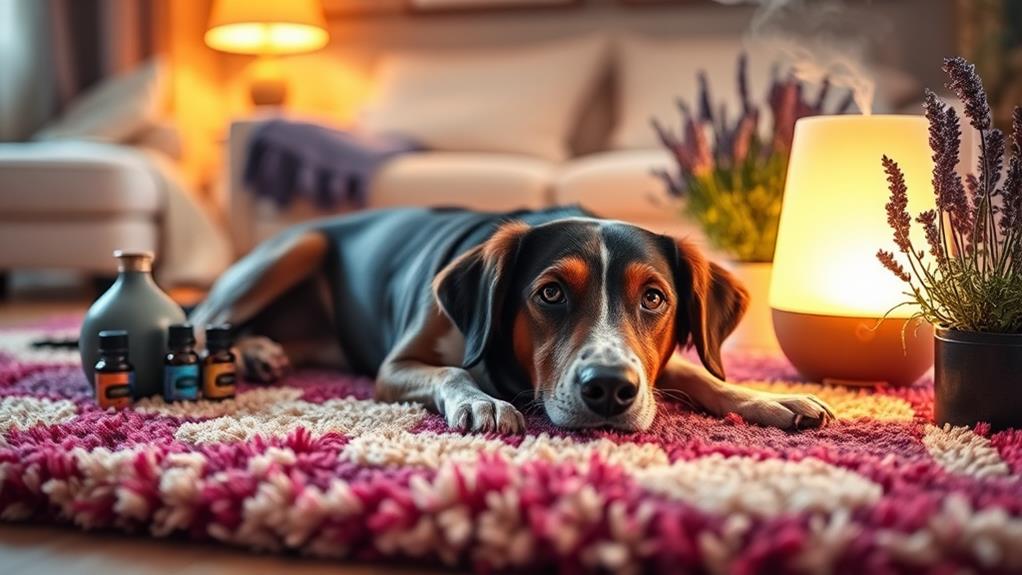
Aromatherapy can be a powerful tool for easing your dog's anxiety and promoting relaxation. By using essential oils, you can create a soothing environment that calms your furry friend. Lavender, chamomile, and bergamot are particularly effective in reducing stress levels in dogs.
To get started, choose high-quality essential oils specifically designed for pets. Avoid using concentrated oils directly on your dog's skin, as they can be too strong. Instead, consider using a diffuser to disperse the scent throughout the room.
You can also add a few drops of essential oil to your dog's bedding or create a calming spray by mixing the oil with water in a spray bottle.
Always monitor your dog's reaction to the scents. Some dogs may love the aroma, while others may not respond well. If your dog shows signs of discomfort, remove the scent immediately. Additionally, consult your veterinarian before introducing any new oils to confirm they're safe for your pet. With the right approach, aromatherapy can be a gentle, effective way to help your dog feel more at ease in stressful situations.
Training for Relaxation
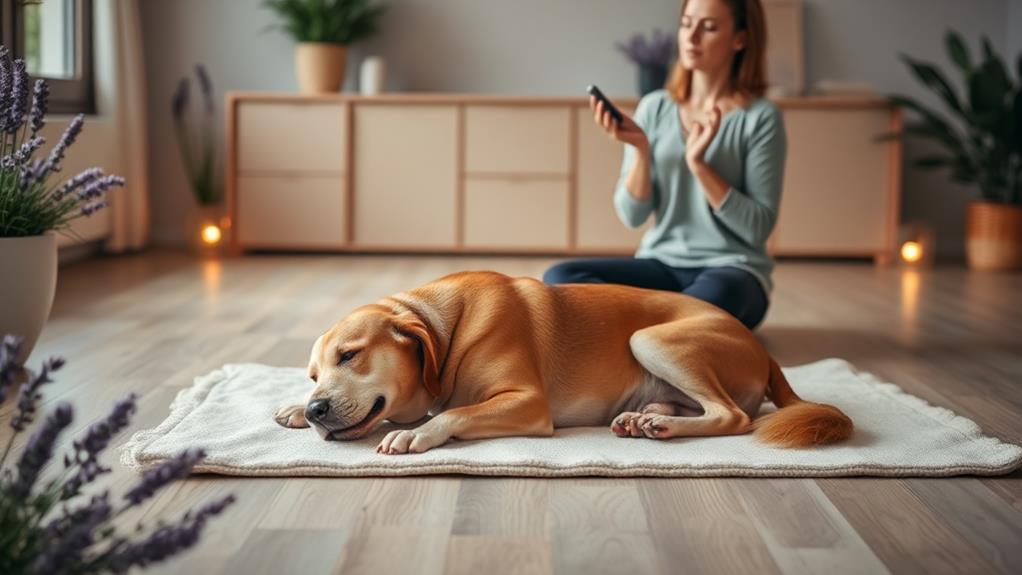
Training your dog to relax can considerably reduce anxiety and improve their overall well-being. By incorporating specific relaxation techniques into their routine, you can help your furry friend feel more at ease.
Create a Calm Environment: Designate a quiet space where your dog can retreat when they feel overwhelmed.
Practice Deep Breathing: Encourage slow, deep breaths by mimicking the action yourself, which can help your dog sync with your calm energy.
Use Positive Reinforcement: Reward your dog for calm behavior with treats or praise, reinforcing the relaxation practice.
Implement Massage Techniques: Gentle massages can help soothe your dog and reduce tension. Focus on areas like the neck and back.
Incorporate Low-Pressure Training: Engage in training sessions that promote relaxation, like teaching "settle" or "place," where your dog learns to lie down quietly.
The Role of Diet

Diet plays a pivotal role in managing your dog's anxiety levels. What your dog eats can profoundly influence their mood and behavior. High-quality, nutritious food supports your dog's overall health and can help stabilize their energy levels, contributing to a calmer demeanor. Look for dog food rich in omega-3 fatty acids, which are known to promote brain health and reduce anxiety.
You might also consider incorporating foods that contain tryptophan, like turkey or chicken, as this amino acid can help boost serotonin levels, naturally calming your pup. Avoid fillers and artificial additives, as these can lead to hyperactivity or digestive issues, exacerbating anxiety.
Additionally, establishing a consistent feeding schedule can create a sense of routine, which is comforting for anxious dogs. Treats can also play a role; opt for calming treats specifically designed for anxious pets.
Always consult your veterinarian before making substantial changes to your dog's diet, especially if they've underlying health conditions. By being mindful of your dog's nutrition, you can take an important step toward reducing their anxiety and promoting a more relaxed, happy companion.
Socialization Strategies
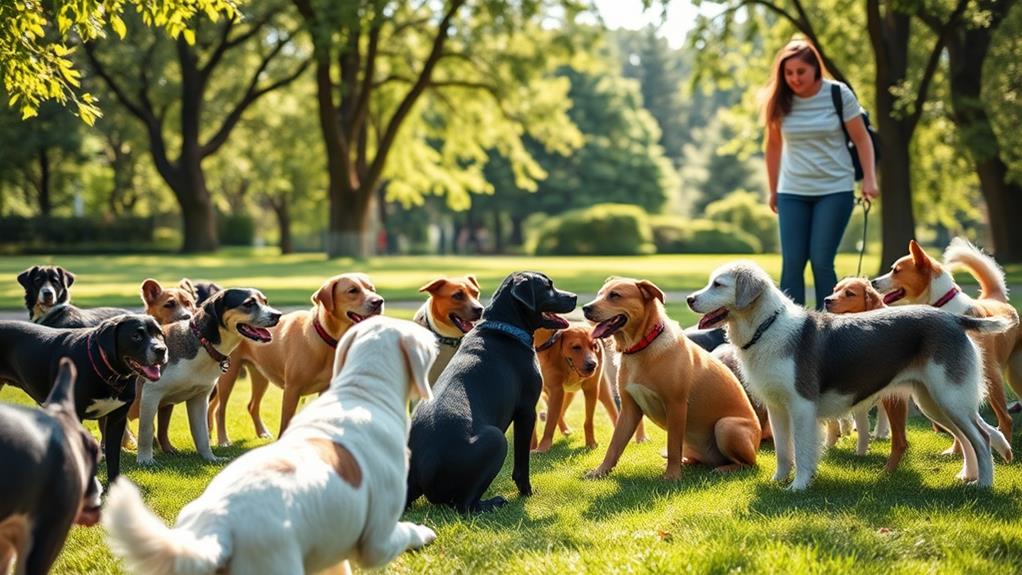
Many dog owners find that effective socialization strategies can markedly reduce their pet's anxiety. By exposing your dog to various situations, people, and other animals, you help them develop confidence and adaptability.
Start Early: If your dog is a puppy, begin socialization as soon as possible. Expose them to different environments, sounds, and people to create positive associations.
Controlled Introductions: Introduce your dog to other pets in a controlled manner. This helps prevent overwhelming situations that could lead to anxiety.
Positive Reinforcement: Reward your dog with treats and praise when they encounter new experiences calmly. This reinforces good behavior and helps build their confidence.
Regular Outings: Take your dog on regular outings to parks, pet-friendly stores, or doggy daycare. This allows them to meet new people and dogs in a safe environment.
Gradual Exposure: Slowly introduce your dog to more challenging situations. Gradual exposure helps them acclimate without feeling overwhelmed.
Professional Help Options

Seeking professional help can be a game changer for anxious dogs, especially when you've tried various at-home techniques without success. A qualified veterinarian can assess your dog's anxiety and may suggest medication or supplements to help manage their symptoms. Don't hesitate to discuss any concerns you have about side effects or long-term use.
Additionally, consider reaching out to a certified dog trainer or behaviorist. They can provide personalized training plans tailored to your dog's specific needs, helping them build confidence and reduce anxiety over time. Look for trainers who specialize in fear-based behaviors and use positive reinforcement methods.
Another option is to consult with a veterinary behaviorist. These specialists combine veterinary medicine with behavioral science, offering thorough evaluations and treatment plans. They can help identify underlying issues contributing to your dog's anxiety.
Frequently Asked Questions
Can Certain Dog Breeds Be More Prone to Anxiety?
Yes, certain dog breeds can be more prone to anxiety. Breeds like Border Collies and Dachshunds often exhibit anxious behaviors. Understanding your dog's breed can help you anticipate and manage their anxiety effectively.
How Can I Tell if My Dog Enjoys a Calming Technique?
You can tell if your dog enjoys a calming technique by observing their body language. If they relax, wag their tail, or nuzzle closer to you, it's a good sign they're enjoying the experience.
Are There Specific Toys That Help Relieve Dog Anxiety?
Studies show 70% of dogs respond positively to interactive toys. You'll find toys like puzzle feeders and squeaky toys can engage your dog's mind, helping to distract them from anxiety and promote relaxation during stressful moments.
Can I Use Calming Techniques for Puppies?
Yes, you can definitely use calming techniques for puppies. Techniques like gentle massage, soothing sounds, and consistent routines help create a secure environment, making it easier for your puppy to feel relaxed and comfortable.
What Should I Do if My Dog Doesn't Respond to Calming Methods?
If your dog isn't responding, imagine a stormy sea—try adjusting your approach. Experiment with different techniques, consult a vet, or seek a trainer. Sometimes, a fresh perspective can calm those turbulent waters.
Conclusion
By implementing these stress-relieving techniques, you can help your anxious dog find peace and happiness. Remember, it's like trying to teach a dog to fetch without a ball; if you don't provide the right tools, progress will be slow. Creating a safe environment, encouraging exercise, and seeking professional help when needed can make a world of difference. Your furry friend deserves a calm, loving life, and with your support, they can thrive!

